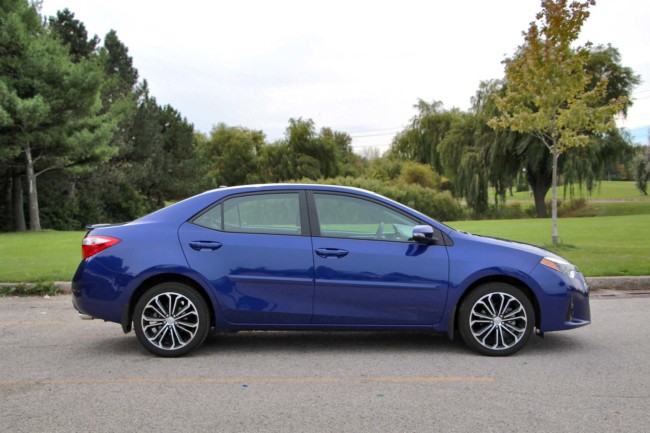While the new Corolla’s engine remains the same between these two as-tested vehicles, the new Continuously Variable Transmission (CVT) changes the Corolla’s character. The 2010’s four-speed automatic leaves the engine chugging along at 3,000 rpm at highway speeds. In the 2015? Under 2,000 rpm. Surely, this will lead to better fuel economy, but to the average driver, it also means you don’t hear the constant hum up front. It is unobtrusive, smooth, and makes passing far easier than it was with the four-speed I’ve grown accustomed to. The 2015 had absolutely no trouble merging with traffic on the heavy, but fast-moving Highway 427.
That actually brings me to the biggest change of this new Corolla – its NVH (Noise, Vibration, and Harshness). I find little change in the car’s comfort-oriented ride, but the new Corolla is quiet and calm, even with larger 17-inch wheels and lower-profile tires. Yes, the new one has built-in Bluetooth, compared to the 2010’s… well, I have a speakerphone hanging on the vanity mirror. Suffice it to say that I currently yell at everyone I speak to and have difficulty hearing my calls. No such issue exists in the 2015. The sound system is likewise improved, though that’s not saying much given how dreary and basic the 2010’s four-speaker setup is.
And while I would not say that a daily commuter requires sharp or precise handling, the 2015 also fixes one of my biggest concerns of the last generation Corolla: lane-drifting on the highway, with or without winds. I endured five-hour weekend commutes each way between Toronto to Ithaca, NY in that 2010 Corolla, with constant corrective steering inputs required to stay within my lane. The 2015, on the other hand, tracks straight and true. It is a true pleasure to drive the new Corolla.
I could go on for several thousand words about each and every minute improvement that Toyota’s engineers painstakingly implemented to keep the Corolla relevant in the constantly changing compact sedan market, but the above points strike me as the most important to a commuter.
Toyota has built on its success here, alienating very few loyal consumers in favour of new fashion. The only omissions are the lack of trunk-mounted rear-seatback folding release mechanisms [picky much? –Ed.], and a 12V power port in the centre console box. Hardly major losses as there is now a USB input up front that will share the duty, and the rear seats continue to fold 60/40 by interior levers.
This new Corolla leaves the one it replaces so far behind that surely there should have been a generation or two between them. I could, and would recommend this vehicle to anyone seeking an inexpensive, economical commuter vehicle.
Thanks Noah, and we’ll be back with one more special entry in our Corolla files before we wrap up this long-term test.


























